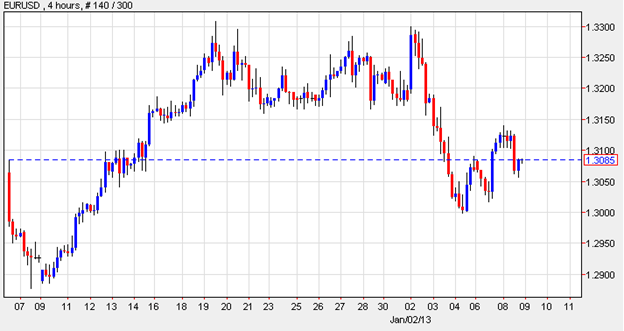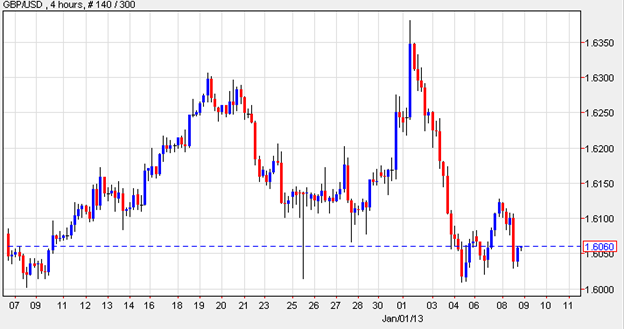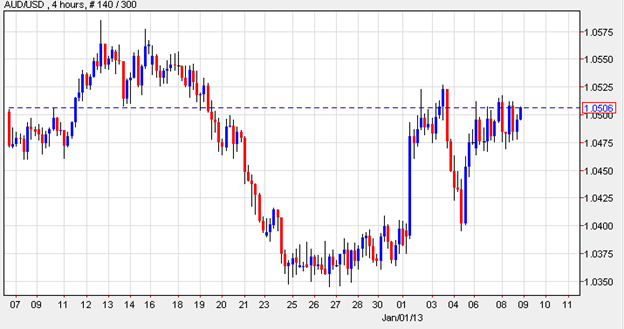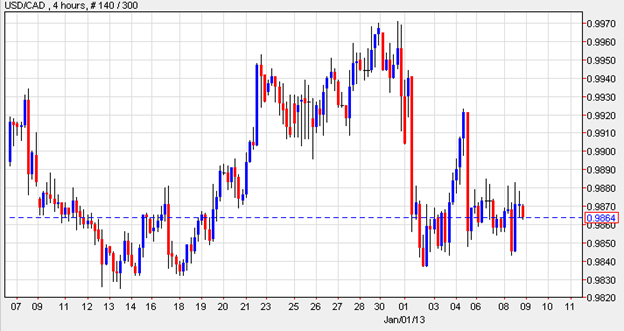The U.S. dollar rallied as demand for safe havens increased following the release of a report which indicated that the U.S. government may run out of money by the month of February. This publication, issued by the Bi-Partisan Policy Center, stated that should this occur, the country would likely default on its bills as soon as February 15th unless Congress agrees to raise the debt ceiling by $1.1 trillion.
Sentiment was also weighed down by news that Unemployment in the Euro-zone increased. On the data front, the economic calendar was light. NFIB Small Business Optimism gained from 87.5 to 88.00 and Economic Optimism rose from 45.1 to 46.5 this month as a result of the recent tax deal.
The Canadian dollar traded lower against its U.S. peer for the first time in three weeks as risk appetite ebbed in the currency exchange following declines in the equities and futures markets. The loonie was also weighed down by lower crude oil prices and forecasts that today’s reports will show slower Housing Starts for December 2012.
The euro weakened after disappointing data suggested that the euro-region’s recovery has come to a halt while Unemployment rose to 11.8 percent and statistics confirmed that 113,000 more people were laid off than in the previous month. Figures also revealed that Retail Sales went up, although not as much as predicted, and German Factory Orders fell short of expectations. The only positive news was that Economic Confidence climbed last month.
The British pound slipped versus all but one of its counterparts ahead of this week’s Bank of England meeting during which policy makers are expected to leave the interest rate unchanged. The sterling remained under pressure as fears over the economy in the euro region reignited, and as investors grew concerned over U.S. fiscal woes. The pound dipped lower after economic data revealed that Retail Sales fell.
The yen extended gains for a second day versus the U.S. dollar as safety flows continued to rise following less than stellar news from both the U.S. and the eurozone. Speculation that all pro-monetary easing measures may have already been priced into the Yen’s decline increased and therefore the currency is not likely to depreciate any further until the central bank actually introduces new stimulus. In the euro region, metrics showed a hike in Unemployment while a U.S. publication speculated that the government may not be able to pay its bills unless the House and Senate agree to raise the debt ceiling.
Lastly, the Australian dollar depreciated for the first time in three days subsequent to a release indicating the South Pacific nation sustained the biggest Trade deficit in over four years. And New Zealand’s dollar dropped after Asian stocks fell by the most in over two weeks, thereby reducing appeal for high-risk assets.
EUR/USD- Eurozone Posts Hike In Unemployment
The 17-nation currency declined after economic reports showed that the euro region’s Unemployment rate went up from 11.7 to a record 11.8 percent in November, a factor that quelled appetite for risk assets. Furthermore, Eurostat data confirmed that Retail Sales only climbed 0.1 percent in November, falling short of the expected 0.3 percent increase. In other news, Germany announced that Factory Orders were lower than expected YoY and MoM.
Overall, orders dipped 1.8 percent due to a drop in demand for European goods and services from other nations abroad. The lackluster publications offset the positive news indicating that the European Stability Mechanism sold 1.92 billion euros of short-term debt. Rumors that the rating agencies may lower France’s credit rating pressured the euro to the downside even as Paris ignored such gossip. On the bright side, the euro region’s Economic Confidence rose from 85.7 to 87.0 last month. EUR/USD" title="EUR/USD" width="624" height="331">
EUR/USD" title="EUR/USD" width="624" height="331">
GBP/USD- Retail Sales Dropped
The British pound declined after negative reports from the U.S. and the euro region dampened risk appetite. In addition, a release from the British Consortium indicated there was a drop in Sales from 0.4 to 0.3 percent when a 0.5 percent increase had been forecast. The sterling began its slow decent in the previous days when reports showed that Services PMI plunged as the leading sector went into contraction territory. Investors now await the Bank of England’s policy meeting scheduled for this week. GBP/USD" title="GBP/USD" width="624" height="329">
GBP/USD" title="GBP/USD" width="624" height="329">
AUD/USD- Aussie Lower On High Deficit
Australia’s dollar declined after the country reported the largest Trade deficit in over four years. According to the data, imports surpassed exports by $2.77 billion (AUD $2.64 billion) in the month of November. This raised speculations the Reserve Bank of Australia will reduce the benchmark interest rate this quarter. The aussie also weakened against the yen on speculation the recent declines of the Japanese currency were excessive. AUD/USD" title="AUD/USD" width="624" height="329">
AUD/USD" title="AUD/USD" width="624" height="329">
USD/CAD- Loonie Drops On Risk Appetite
The U.S. dollar traded higher against the Canadian currency as risk appetite took a hit following the release of disappointing economic reports out of the euro region, and as a publication out of the U.S. highlighted the severity of the fiscal situation. The loonie extended losses as crude oil, the nation’s biggest export fell 0.1 percent to $93.15 per barrel in the New York Mercantile Exchange. Canada’s dollar remained under pressure on speculations today’s releases will show a slowdown in Housing Starts, a factor that may indicate the real estate market is heading for a “soft landing.” USD/CAD" title="USD/CAD" width="624" height="331">
USD/CAD" title="USD/CAD" width="624" height="331">
Today’s Outlook
Today’s economic calendar shows that the U.K. will report on the Trade Balance. The euro region will release the GDP. Canada will issue Housing Starts. New Zealand will publish Trade Balance and Australia will announce Building Approvals. It’s possible that China will report on the country’s Trade Balance.
- English (UK)
- English (India)
- English (Canada)
- English (Australia)
- English (South Africa)
- English (Philippines)
- English (Nigeria)
- Deutsch
- Español (España)
- Español (México)
- Français
- Italiano
- Nederlands
- Português (Portugal)
- Polski
- Português (Brasil)
- Русский
- Türkçe
- العربية
- Ελληνικά
- Svenska
- Suomi
- עברית
- 日本語
- 한국어
- 简体中文
- 繁體中文
- Bahasa Indonesia
- Bahasa Melayu
- ไทย
- Tiếng Việt
- हिंदी
USD Rallies As Demand For Safe Havens Increases
Published 01/09/2013, 04:55 AM
Updated 09/16/2019, 09:25 AM
USD Rallies As Demand For Safe Havens Increases
Latest comments
Loading next article…
Install Our App
Risk Disclosure: Trading in financial instruments and/or cryptocurrencies involves high risks including the risk of losing some, or all, of your investment amount, and may not be suitable for all investors. Prices of cryptocurrencies are extremely volatile and may be affected by external factors such as financial, regulatory or political events. Trading on margin increases the financial risks.
Before deciding to trade in financial instrument or cryptocurrencies you should be fully informed of the risks and costs associated with trading the financial markets, carefully consider your investment objectives, level of experience, and risk appetite, and seek professional advice where needed.
Fusion Media would like to remind you that the data contained in this website is not necessarily real-time nor accurate. The data and prices on the website are not necessarily provided by any market or exchange, but may be provided by market makers, and so prices may not be accurate and may differ from the actual price at any given market, meaning prices are indicative and not appropriate for trading purposes. Fusion Media and any provider of the data contained in this website will not accept liability for any loss or damage as a result of your trading, or your reliance on the information contained within this website.
It is prohibited to use, store, reproduce, display, modify, transmit or distribute the data contained in this website without the explicit prior written permission of Fusion Media and/or the data provider. All intellectual property rights are reserved by the providers and/or the exchange providing the data contained in this website.
Fusion Media may be compensated by the advertisers that appear on the website, based on your interaction with the advertisements or advertisers.
Before deciding to trade in financial instrument or cryptocurrencies you should be fully informed of the risks and costs associated with trading the financial markets, carefully consider your investment objectives, level of experience, and risk appetite, and seek professional advice where needed.
Fusion Media would like to remind you that the data contained in this website is not necessarily real-time nor accurate. The data and prices on the website are not necessarily provided by any market or exchange, but may be provided by market makers, and so prices may not be accurate and may differ from the actual price at any given market, meaning prices are indicative and not appropriate for trading purposes. Fusion Media and any provider of the data contained in this website will not accept liability for any loss or damage as a result of your trading, or your reliance on the information contained within this website.
It is prohibited to use, store, reproduce, display, modify, transmit or distribute the data contained in this website without the explicit prior written permission of Fusion Media and/or the data provider. All intellectual property rights are reserved by the providers and/or the exchange providing the data contained in this website.
Fusion Media may be compensated by the advertisers that appear on the website, based on your interaction with the advertisements or advertisers.
© 2007-2025 - Fusion Media Limited. All Rights Reserved.
